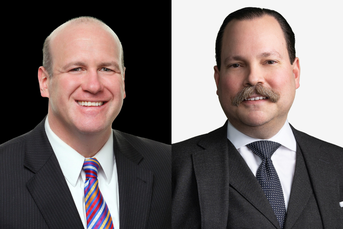SEC advice rule contains a huge hole

Jay Clayton aims to clear up investor confusion by drawing a distinction between brokers and advisers in the agency's proposed package of revised standards. But where do dual registrants fit?
The SEC’s new advice reform package contains a huge hole.
While some brokers will be forbidden to use the title financial adviser or advisor, another few hundred thousand will still be able to do so. The Securities and Exchange Commission’s goal of tackling investor confusion won’t be met for people working with the growing number of dually registered advisers. The title ban does not apply to those registered as both brokers and advisers — even when that person has their broker hat on.
“Our proposal would not prohibit dually registered firms or dually hatted financial professionals from using 'adviser’ or 'advisor’ in their names or titles, even in circumstances where the firm or financial professional provides brokerage services to a particular investor,” the proposal states.
This is a Mack truck-sized loophole that a large portion of the financial advice sector can drive through. The SEC estimates that 61% of registered representatives work at dually registered firms. The agency also found that 72% of registered representatives working at firms with between $1 billion and $50 billion in assets under management are with dually registered firms.
“The rule literally doesn’t apply to most advisers,” said Michael Kitces, partner and director of wealth management at Pinnacle Advisory Group.
Out of the total pool of 630,132 broker-dealer registered individuals, 286,799 are dually registered as an investment adviser representative as well, according to the Financial Industry Regulatory Authority Inc. Another 56,472 are registered as IARs only.
Though a major impetus for advice-standards reform was to help investors distinguish an adviser from a broker and know what to expect when dealing with either one, the rule fails to address the most confusing aspect of the industry: financial professionals who sometimes are brokers and sometimes are advisers when working with the same client.
COMMENT LETTERS
The feedback SEC chairman Jay Clayton and the other commissioners are getting in many of the thousands of comment letters on the proposal involves this carve-out.
Mr. Kitces said it undermines the whole proposal.
“Condoning it and sanctioning it doesn’t resolve the investor confusion. It amplifies it,” he said. “It’s the complete opposite of what chairman Clayton said he wanted to achieve.”
David Bellaire, executive vice president and general counsel at the Financial Services Institute, thinks the SEC proposal gets it right in allowing dually registered advisers to continue to call themselves financial advisers regardless of the type of account they’re working on with a client.
He points to the example of a client with a 529 college savings plan on which an adviser charges commissions and an individual retirement account on which she charges fees. The adviser is likely to talk with the client about those accounts as well as several others during a typical meeting.
“It would be extremely confusing to the investor to have a dually registered adviser clarify their title with respect to each account,” Mr. Bellaire said. Being a financial adviser across all of them “is much more digestible for investors.”
In that case, said Fred Reish, partner at Drinker Biddle & Reath, “a better approach is if the SEC says that anyone who holds themselves out as an adviser will be held to the [registered investment adviser] best interest/fiduciary standard, even if they end up acting as a broker.”
As it stands now, simply exempting dual registrants from restrictions on using “adviser/advisor” in their title is a “glaring mistake by the SEC,” Mr. Reish said.
Mr. Clayton has heard the criticism.
“We appreciate the constructive engagement on these issues, which are critical to Main Street investors, and are actively reviewing all comments on the proposed rules,” an SEC spokesperson said in a statement.
Ira Hammerman, executive vice president and general counsel at the Securities Industry and Financial Markets Association, thinks the SEC proposal would increase investor protection. He disagrees with critics’ assertions that the brokerage side of a dual registrant’s work can lead to investor harm.
“They hide behind the wonderful word 'fiduciary,’ with its comparatively lax regulatory oversight, and lob stones at the more heavily regulated brokerage business model,” he said.
Under the SEC’s proposal, brokers and advisers continue to be regulated separately — with brokers being subject to the so-called Regulation Best Interest, which requires them to act in the best interests of their clients, and advisers adhering to their current fiduciary standard.
For dually registered advisers, that means they will have to continue to act as a fiduciary in advisory accounts and will be held to a less-stringent though heightened standard in brokerage accounts.
“The industry is in favor of elevating the suitability standard, not that it was weak or poor,” Mr. Hammerman said. “Now, it will accelerate the brokerage side becoming even more professional, and that’s in everyone’s interests.”
Regulation Best Interest does require brokers to tell clients when they are acting in a brokerage capacity in making a recommendation. But the client doesn’t always know when a financial professional is making the transition between being a broker and an adviser, and vice versa.
The SEC proposal “does not provide strict guidelines about when they have to make that distinction about what capacity they’re working in,” said Korrine Kohm, director of retail wealth management at Compliance Solutions Strategies. “The biggest area of grayness is the dually registered space, and that’s where the rule did not go far enough.”
A RED HERRING?
Mr. Hammerman asserts that warnings about hat-switching by dual registrants are a “red herring” that unfairly portrays brokers as being bad and advisers good.
“The hats on, hats off criticism is a head fake,” he said. “The notion of, 'Aha, I’ve got them on the brokerage side, so now I’m going to take advantage of them’ — that’s not how business is done. The focus is always on putting the client first.”
But the two roles are regulated differently. And that’s what the SEC set out to clarify in the first place.
Under the SEC proposal, financial professionals are supposed to present the client with a so-called client relationship summary that delineates the differences between advisers and brokers in terms of standards of care, services and compensation.
The sample Form CRS for dual registrants — titled “Which Type of Account is Right for You – Brokerage, Investment Advisory or Both?” — puts too much responsibility on the investor to figure it out, Mr. Reish said.
“I don’t think the typical Main Street investor will understand what they need to do with that information,” he said. “If people can’t tell when they’re getting commission-based advice versus fee-based advice, then the concept falls apart.”
The SEC proposal does little to help the investor decide whether to establish a brokerage or advisory account with the dual registrant, said Barbara Roper, director of investor protection at the Consumer Federation of America.
“The rule does nothing to ensure that the initial recommendation about what kind of account you should open is going to be in your best interest,” Ms. Roper said. “It leaves them with these generic, vague and impenetrable disclosures to try to make that decision for themselves.”
Whether investors benefit from Form CRS when it comes to parsing dual registrants depends on how firms write the disclosure, said Bob Lavigne, managing director and head of compliance solutions at Bates Group.
“What it’s going to come down to is how it’s executed,” he said. The SEC is “going to want to see a plain-English document that is easy for the average investor to understand.”
ONE STANDARD
The most straightforward regulatory way to take this burden off of the consumer would be for the SEC to propose a fiduciary standard across all types of accounts, Ms. Roper said.
“You adopt a uniform standard and you make it a tough standard,” she said.
SEC commissioner Robert Jackson Jr. agrees.
“Investors are especially at risk when working with a dual-hatted entity because it’s hard to tell at what moment that person stops being a broker and starts being an adviser,” Mr. Jackson said. “That’s why what really makes sense in this area is to have one standard that requires investors to come first. Ambiguity is good for lawyers but not for investors.”
Other commissioners contacted were not available to comment on the mattter.
A uniform standard is what the Labor Department attempted to enact with its fiduciary rule for retirement accounts, but financial industry opponents defeated the measure in court. Critics of a uniform fiduciary standard argue it’s not appropriate for brokerage accounts and applaud the SEC for maintaining separate broker and adviser standards of care.
Daniel Bernstein, chief regulatory counsel at MarketCounsel, suggests two other approaches.
One would be to change the name of Regulation Best Interest to Regulation Suitability so investors know it is a modification of the current broker standard. That would alleviate any confusion that the broker “best interest” requirement is the same as the advisers’ fiduciary standard.
He also noted the SEC could enforce the broker exemption already in the Investment Advisers Act of 1940 that requires financial professionals to register as advisers if they give advice that is more than “solely incidental” to their brokerage services.
“If they’re giving advice that’s not incidental, then they’ll be investment advisers and all of this will be cleared up,” he said.
But brokers so frequently have crossed the “solely incidental” line over recent decades that the SEC doesn’t seem to have an appetite for redrawing it.
Instead, reworking the SEC proposal to address hat-switching and investor awareness of dual registrants could be a start, but it’s going to be a heavy lift, according to Mr. Kitces.
“You’re going to end up redoing the rule because it is harder; it is messy,” he said. “The fact that it’s messy is why there’s so much investor confusion and why it matters.”
Learn more about reprints and licensing for this article.








